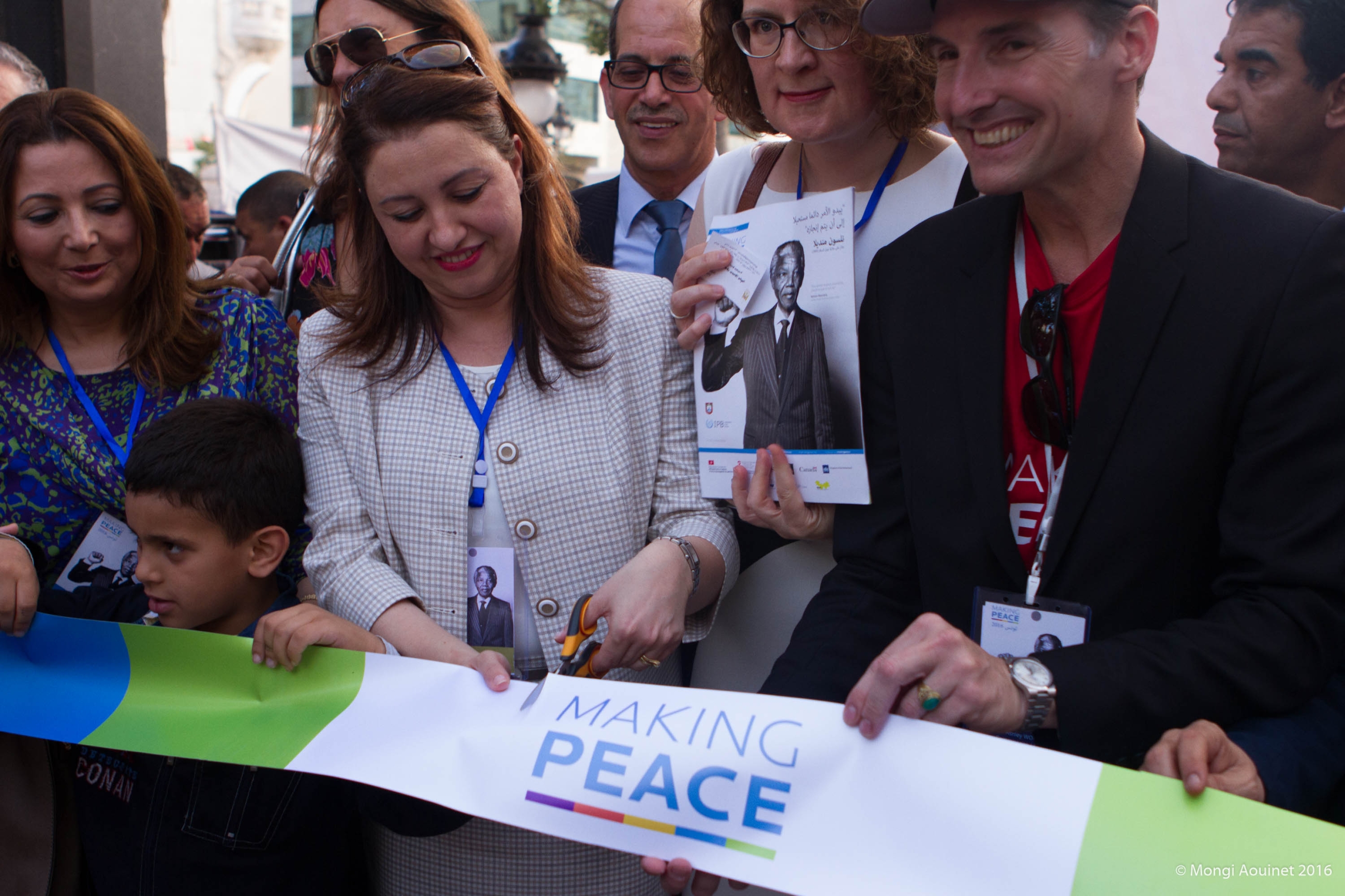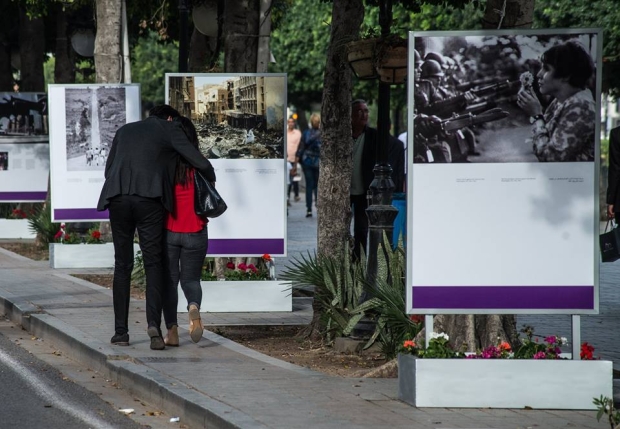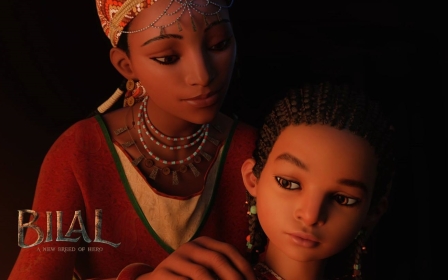Promoting peace through photographs in Tunis

For most of its history, Avenue Habib Bourguiba, the tree-lined thoroughfare that cuts through downtown Tunis, was not known as a place of political protest. The street, named after Tunisia’s first president (and dictator) was modelled off the Champs Elysees in Paris. There are shops, restaurants and cafes filled with people, and at one end of the avenue, a clock tower built by the country’s second dictator, Zine El Abdine Ben Ali. At the other end is the imposing Ministry of Interior.
During the 2011 revolution, the avenue became a centre of protest, as thousands of Tunisians marched through the street demanding the resignation of Ben Ali. In the past five years, as Tunisia continues to undergo a process of democratic transition, Avenue Bourguiba still plays host to countless demonstrations. And for the next three months, the broadway will be a home to a new art exhibit: Making Peace.
The world’s largest photographic exhibition exploring the concept of peace, it features 125 photographs taken by 111 photographers in dozens of countries and spans a century of conflict and struggle. The exhibition’s goal is to explore ways in which we can promote sustainable peace, and focuses on five topics: disarmament and nonviolence, conflict prevention and resolution, economic and social justice, human rights, law and democracy, and environment and sustainable development.
Since 2010, the exhibit has made its way around the world and arrives in Tunis for its debut in the Arab world. The choice of Tunisia, which coincides with the five-year anniversary of the country’s revolution, was deliberate.
“In presenting Making Peace in Tunisia and specifically along Avenue Habib Bourguiba, we pay tribute to the courage of the Tunisian people, as well as civil society organisations such as the World Organisation Against Torture (OMCT), and the Arab Institute for Human Rights (AIHR) - both key partners of Making Peace - in helping to build a safer and more sustainable future for Tunisia and for the rest of the Arab World,” Ashley Woods, the curator of Making Peace, told Middle East Eye.
The photographic collection, which is spread out along the avenue, emphasises the universality of peace. At the start of the exhibit, there’s an image of a Congolese man mowing down a tree with a chainsaw. In front of Tunis’ Municipal Theatre, a polar bear is seen desperately clinging to a melting block of ice. A few meters down, two women stop in front of a series of headshots - Cambodian victims of the Khmer Rouge.
There are photographs of Iraqi and Kurdish refugees, protests in Latin America, survivors of the Chechnyan war, and a recently married couple dressed in flowing white gauze standing atop rubble in a bombed-out Beirut. There are images of the makeshift shelters refugees built themselves in Calais, and smartly suited American financial CEOs standing to attention in courtrooms. The iconic photo of Kim Phuc, running naked in open-mouthed agony after her village was bombed with napalm during the Vietnam War, is here too.
“Making Peace doesn't specifically address the process of peace in Tunisia,” Woods acknowledged, though he pointed out that “it does provide an opportunity for Tunisians to reflect and compare their own experiences with other peoples and similar events over the past century represented in the exhibition.”
Since the country ousted Ben Ali, Tunisia has held democratic elections, organised a National Dialogue Quartet, drafted a new constitution that expands on personal freedoms, and was awarded a Nobel Peace Prize. A public art exhibit boldly showcasing instances of people power, blatant struggle against injustice, and the tyranny of imperialism would have been unheard of before 2011.
But Tunisia continues to be in a period of transition, and is currently addressing wrongdoings committed during the Bourguiba and Ben Ali regimes. In 2013, the country passed a comprehensive Transitional Justice Law, which addresses thousands of cases of human rights abuses over the last 60 years: economic corruption, torture, sexual abuse, police brutality, random killings, and more. A Truth and Dignity Commission (TDC) was set up to manage the 33,000 cases; the TDC is in its final stages of collecting testimonies.
Making Peace’s opening only coincidentally aligns with the tail end of the TDC, but it’s telling of Tunisians commitment to securing justice for themselves. It’s of course an ongoing struggle - Tunisian civil society groups have reported that even post-revolution, torture and police abuse continue.
“Peace - unlike war - is a slow process that necessitates a great deal of patience and courage to forgive and move forward,” Woods said. “I think in this sense the Tunisian people are an example to us all.”
Making Peace is exhibited on Avenue Bourguiba, Tunis. The show will run through September. If you are interested in bringing Making Peace to your country, please email Ashley Woods at [email protected]
New MEE newsletter: Jerusalem Dispatch
Sign up to get the latest insights and analysis on Israel-Palestine, alongside Turkey Unpacked and other MEE newsletters
Middle East Eye delivers independent and unrivalled coverage and analysis of the Middle East, North Africa and beyond. To learn more about republishing this content and the associated fees, please fill out this form. More about MEE can be found here.






